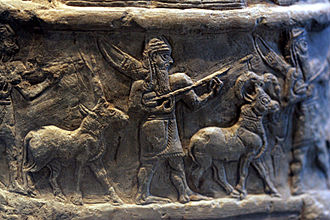| Zababa-šuma-iddina | |
|---|---|
| King of Babylon | |
 Detail from unfinished kudurru found at Susa | |
| Reign | 1158 BC |
| Predecessor | Marduk-apla-iddina I |
| Successor | Enlil-nādin-aḫe |
| House | Kassite |
Zababa-šuma-iddina[nb 1] was the 35th and penultimate king of the Kassite or 3rd dynasty of Babylon, who reigned for just one year,[i 1] ca. 1158 BC (short chronology). He was without apparent ties to the royal family and there is uncertainty concerning the circumstances of his coming to power.
Biography
Ascendancy
A late Assyrian tablet provides a prophetic narrative and suggests it was his predecessor Marduk-apla-iddina I, who did indeed reign for 13 years, and who was overthrown by the Elamites, perhaps combining the two sequential reigns into a single individual:
A prince will arise and will exercise kingship for 13 years. There will be an attack of Elam on Babylonia and the booty of Babylonia will be carried off. The shrines of the great gods will be ruined and Babylonia will be defeated. There will be chaos, upset, and trouble in the land, and the upper classes will lose power. Some other, unknown person will arise, will seize power as if a king, and will kill off the nobility.[1]—Prophecy A, Tablet[i 2]
Invasions by Assyria and Elam
His short unhappy reign was subjected to invasions on two different fronts. One of these was where Assyrian forces under the leadership of Aššur-dan I annexed the region lying between the Lower Zab and the Adhaim, or Al Uzaym River, seizing control of Zaban, Irriya and Urgarsallu, and carrying off much plunder.[i 3]
His lack of connection to the previous royal family into which the Elamite rulers had intermarried for several generations led Shutruk-Nahhunte, king of Elam and who was himself married to the thirty-third Babylonian king Meli-Šipak’s eldest daughter, to believe his claim to the throne of Babylon was more legitimate.[2] A Neo-Babylonian copy of a literary text which takes the form of a letter, now located in the Vorderasiatisches Museum in Berlin, is addressed to the Kassite court by an Elamite King, thought to be Shutruk-Nahhunte, and details the genealogy of the Elamite royalty of this period. He casts aspersions on their choice of king and then declares:
Why I, who am a king, son of a king, seed of a king, scion of a king, who am king (?) for the lands, for the land of Babylonia and the land of [El]am, descendant of the eldest daughter of the mighty King Kurigalzu, (why) do I not sit on the throne of the land of Babylonia? I sent you a sincere proposal; you however have granted me no reply: you may climb up to heaven – [but I’ll pull you down] by your hem; you may go down to hell – [but I’ll pull you up] by your hair! I shall destroy your cities, dem[olish] your fortresses, stop up your (irrigation) ditches, cut down your orchards, [pull out] the rings [of the sluices] at the mouths of your (irrigation) canals…[3]—Shutruk Nahhunte?, Letter to the Kassite court.[i 4]
There are some concerns over the authenticity of this “letter” as it makes a derogatory reference to a later king, Nabu-apla-iddina, ca. 888 – 855 BC. It may, however, preserve some traditions of the period.
Shutruk-Nahhunte led an assault on northern Babylonia which resulted in the end of Zababa-šuma-iddina’s reign. The event is described in a late Babylonian poetic text[i 5] purporting to be narrated by a later king, possibly Nabû-kudurrī-uṣur I.[4] He left his inscriptions on many of the trophies he collected for display in the temples of Susa, each with its boastful addendum, to confirm it was he who had conquered Babylonia. A fragment of an Elemite stele describes crossing the river Ulai and seizing seven hundred towns. Another fragment lists the northern cities that had been overthrown including Dur-Kurigalzu, Sippar, Opis, perhaps Akkad and Eshnunna.[5]
Inscriptions
Notes
- ↑ Written as mdZa-ba4-ba4-MU-AŠ.
References
Cite error: Invalid <references> tag;
parameter "group" is allowed only.
<references />, or <references group="..." />- ↑ W.G. Lambert (1978). "The Ethel M. Wood Lecture delivered before the University of London on 22 February 1977". The Background of Jewish Apocalyptic. London: The Athlone Press. p. 10.
- ↑ D. T. Potts (April 2006). "Elamites and Kassites in the Persian Gulf". Journal of Near Eastern Studies. 65 (2): 111–119. doi:10.1086/504986.
- ↑ Daniel T. Potts (1999). The archaeology of Elam: formation and transformation of an ancient Iranian State. Cambridge University Press. pp. 206–208.
- ↑ J. A. Brinkman (1976). "Zababa-šuma-iddina". Materials for the Study of Kassite History, Vol. I (MSKH I). Oriental Institute of the University of Chicago. p. 321.
- ↑ Elizabeth Carter, Matthew W. Stolper (1984). Elam: surveys of political history and archaeology. University of California Press. p. 40.